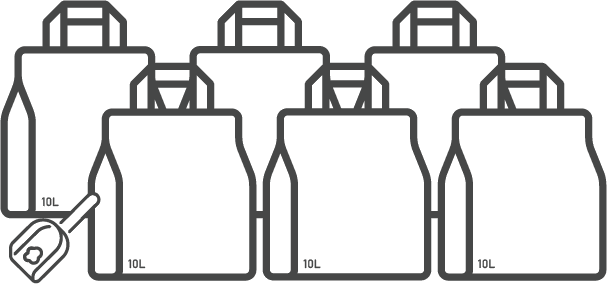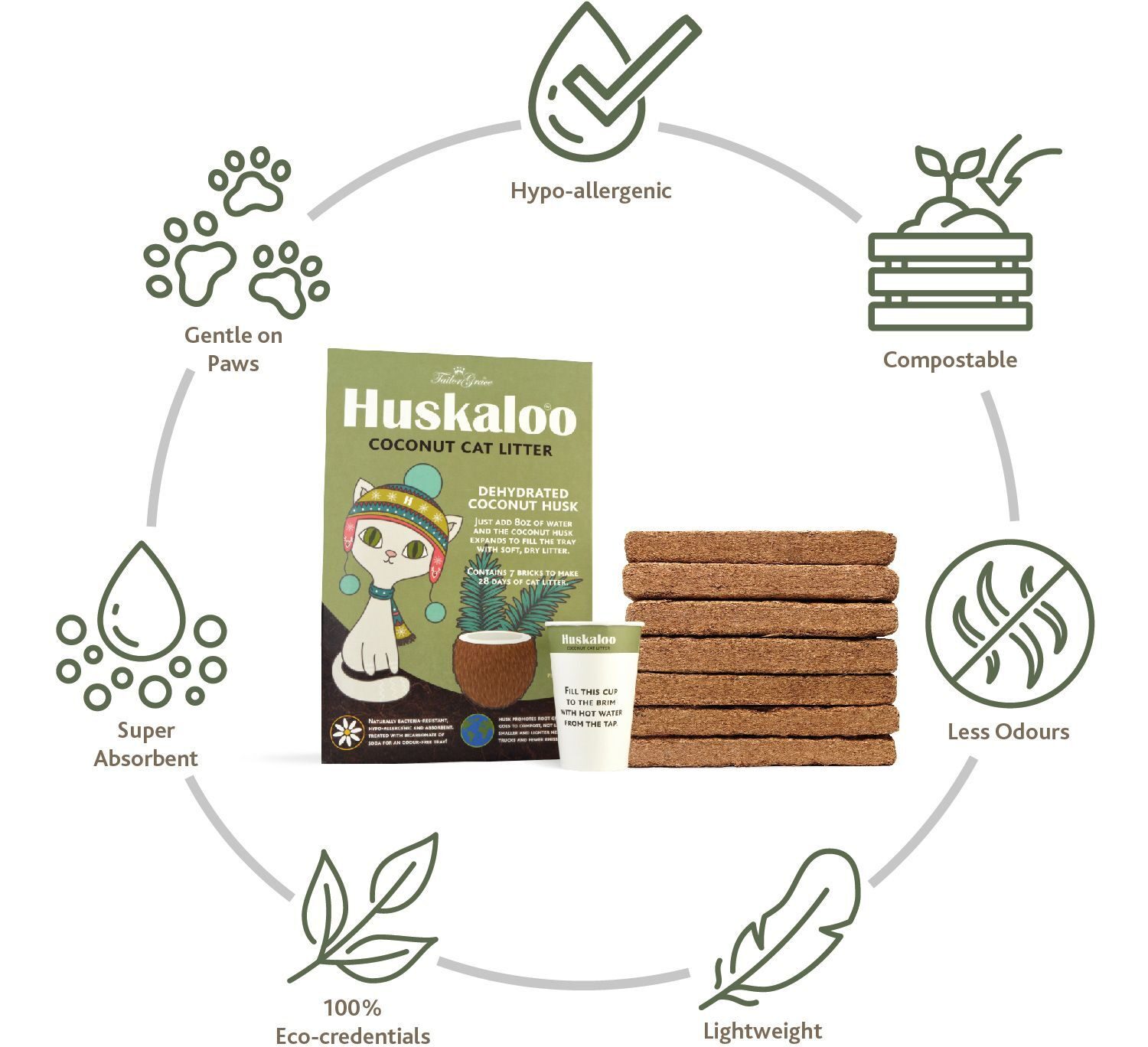Advice? Call +32(0) 56 25 40 82
What are the differences between cat litter products? Which cat litter is best? Which cat litter is the most ecological? Clumping or non-clumping? Organic? What do cats like the most? Do you also sometimes ask 1 of these questions? More info on cats and their sacred space below 😊.
Smell
If cats do not like the smell of the cat litter, either because it is artificial, or smells strong like corn or pine, or because it has the ammonia smell of their own pipi. So they will be reluctant to use the bin and go elsewhere to use the toilet.
Texture
Cat litter varies from very fine texture to large pellets and from soft texture to hard. Generally, they prefer soft texture and fine, like sand. But finer texture sticks to paws and is followed throughout the house and sticks to the fur, especially in long-haired cats. If the litter is uncomfortable to use, cats are unlikely to use it.
Clumping
Some cat litter such as cornmeal, clumps naturally. Some have chemicals added to make them clump. Those chemicals can be harmful to a cat’s health and the environment. Clumping turns urine into clumps that can be removed, promoting freshness. If the litter is sufficiently absorbent, it does not need to clump together and you do not need to remove clumps daily.
Sustainability
What makes a litter greener? Plant-based cat litter is generally more durable. Mineral fill such as clay, quartz sand, limestone, chalk and silica need to be mined. For reducing transport emissions, the smaller and lighter the better.
Mining for cat litter is a disaster. Strip mining removes soil and trees and habitats for wildlife, this can lead to flooding and pollution and carries the additional energy and emission costs of transporting heavy waste worldwide. An estimated 2.5 million tonnes of clay cat litter goes to landfills in the UK every year. This is equivalent to 200,000 Belgian trucks.
Renewable, sustainable sources are best because they are free of added chemicals and toxins and come in eco-friendly packaging. Biodegradable material that does not need to go to landfill.
Recycled paper, by-product wood and plant by-products are the most environmentally friendly.
Flushability
Some cat litter products advertise themselves as flushable. This is never a good idea. Cat litter liners are absorbent and expand. As a result, they can cause plumbing blockages, especially clay waste that can leave residues such as concrete.
Cost
Calculating the cost of cat litter seems tricky, but the important number is how much it costs, per cat, per month. Price per litre does not tell the whole story. The key factors above price per litre are how much litter you need in the bin and how long it lasts while remaining fresh and functional. Cost per cat, per month. The only amount that matters.

Clay litter
The original cat litter. Sand or earth replaced it in earlier litter boxes. Clay cat litter is declining in popularity.
Clay has been in use as a cat litter since the early 1900s. In 1947, Edward Lowe in Michigan USA used granulated clay for its absorbency to clean up oil and grease stains. He was the first to market clay commercially as a cat litter called “Kitty Litter”.
Clumping clay cat litter was developed in the 1980s. Bentonite clay is derived from volcanic ash and is quite absorbent. Odour control is usually only the clumping aspect, which allows the removal of clumped urine.
Advantages – clumping, cheap.
Disadvantages – Heavy, bulky. Bentonite dust is considered harmful to inhale. Dust is tracked around the house. Economically harmful, comes from strip mining. Very harmful to nature and can only be disposed of in landfill.
Cat litter made from wood or paper pallets.
Biodegradable and from recycled sources such as newspapers and sawdust.
Advantages – Highly absorbent. Less dusty and dust is less harmful. Recycled. Compostable. Lighter than clay.
Disadvantages – Crumbling pellets follow through the house. Cats don’t seem to like walking on pellets. Paper litters do not clump well and do not block odours well.
Biodegradable cat gravel in pellet form
Granulated wheat, maize, barley, pine. By-products of the human and animal food industry.
Plus points – Green. Biodegradable and made from renewable resources. Can be composted or flushed. Lighter than clay. Lasts twice as long as clay.
Cons – Easy to track around the house. Dusty (but not a hazardous substance). Does not prevent odours well and can smell even from the bag. Odour of pine, wheat, corn etc.
MAÏS (and other cereals) STROOISEL
Sandy texture. Clumping or not clumping.
Benefits – Quick clumping helps reduce odour by removing urine. Cats like the texture. Natural. Half the weight of clay, twice as absorbent. Flushable, but flushing cat litter is not recommended. Lighter than clay but heavier than some wood or other vegetable litters. Not much dust.
Disadvantages – Usually expensive. Sticks easily to paws and tracks around the house. Natural smell can be quite strong from the box. Artificial smells like pine can be overwhelming. Corn-based litters can develop a fungus called Aflatoxin, which is very harmful to animals.
Wheat is an alternative to corn, but does not clump as well and can be an allergen for cats.
Grass is very lightweight and clumps well. Follows easily.
Silica gel cat litter
Made from pellets of sodium silicate.
Advantages – Good absorbency. Economical to use, usually the cheapest cat litter. Lightweight. Usually dust-free.
Disadvantages – Many cats hate it. It tracks around the house very easily. Round beads roll for miles, while oddly shaped beads can be sharp and uncomfortable on paws. Absorbent but reaches saturation very suddenly, at this point it smells directly of urine. Mined mineral – environmentally unfriendly.
Tofu cat litter
Made from soybean pulp. Comes in scented and unscented and different consistencies from pellets to pellets. Pellet versions are more expensive but much less dusty.
Advantages – Pellets contain little dust, pellets less. More absorbent than clay. Non-toxic, non-odorous versions are natural, “flushable”, biodegradable and compostable. Clumping.
Disadvantages – Half as absorbent and four times heavier than Huskaloo. Fairly pricey solution. Granules are very dusty. Beware of “flushable” as flushing cat litter is not advised due to the possibility of spreading harmful bacteria. Natural odour can be strong and unpleasant.
HUSKALOO KOKOS CAT LITTER FILLING – The only compact & super ecological solution.
Made from compacted, dehydrated coconut husk. Sustainable, natural resource, by-product of the coconut industry.
Benefits – 90% smaller and 90% lighter than clay, and up to ten times more absorbent. Can be composted. 100% recyclable. Dust-free. Odour-free and pleasant natural smell from the box. Cats like it. 1.7 kg can last a cat two months. Does not follow easily through the house. Very green. Lower transport costs, easier storage, nothing has to go to the landfill. Coconut fibres are locally dehydrated, the compressed bricks are 1/10 the size and weight of clay litter to transport. These have a vastly smaller carbon footprint, 100% natural, just coconut husk and bicarbonate of soda.
Disadvantage – 40 seconds preparation time, 30 seconds to rehydrate brick with hot water, 10 seconds to break the brick.
